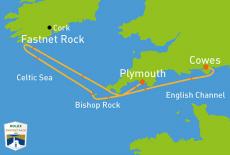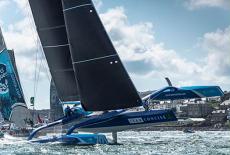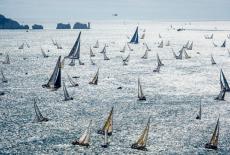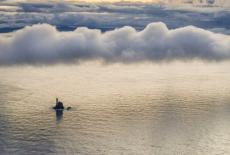368 Boats Start 605 Mile Rolex Fastnet Race

06.08.2017
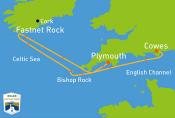
47th Fastnet Race Sponsored By Rolex
The Solent laid on ‘classic’ conditions for the upwind start of the Royal Ocean Racing Club’s (RORC) 47th Rolex Fastnet Race.
Nine high performance multihulls led the fleet as the first start got underway at 11.00 on Sunday 6 August from Cowes, Isle Of Wight. In total a record fleet of 368 boats started, confirming the Rolex Fastnet Race as the world’s largest offshore yacht race.
Some offshore yacht races struggle for entries, but the RORC's biennial flagship event is not one of them. When the entry list opened on 9 January, spaces sold out in just over 4 minutes. This Fastnet race will also be the first occasion the eight VO65s, set to compete in this year's Volvo Ocean Race, will line up in anger.
The testing course passes several famous landmarks on the south coast of England. Initially, the race heads westward down The Solent, exiting into the English Channel at Hurst Castle. Yachts race around Lands End then sail across the Celtic Sea.
The legs across the Celtic Sea, to and from the Fastnet Rock, are long and unpredictable. Openly exposed to fast moving Atlantic weather systems the fleet often encounters the toughest weather of the race on its approach to and return from Ireland. In 1979 gale force winds and violent seas caused havoc as 18 lives were lost and less than a third of the fleet finished the race.
The symbol of this epic race is the Fastnet Rock, located off the southern coast of Ireland. Also known as the Teardrop of Ireland, the rock marks an evocative turning point for this challenging race. Yachts then sail back, leaving Bishop Rock and the Scilly Isles to port, en route to the finish off Plymouth.
The race attracts both professionals and amateurs, sailing a uniquly diverse fleet of boats, from classic yachts to some of the fastest racing machines on the planet. The diversity of the yachts and participants is truly extraordinary, with yachts ranging from 30 to140 feet taking part on the same race course.
The Fastnet Race, which has taken place since 1925, was one of the earliest true tests of offshore sailing. It is legendary within the world of ocean racing. Flawless decision-making, determination and total commitment are the essential requirements as crews manage and anticipate the changing tidal and meteorological conditions imposed by the complex course.
Course records for the 605 nautical miles Fastnet Race:
Multihull: 1 day, 8 hours, 48 minutes
Monohull: 1 day, 18 hours, 39 minutes
In 2011 the multihull race record was set by French trimaran, 'Banque Populaire V', skippered by Loick Peyron with a total elapsed time of 32 hours, 48 minutes and an average speed of 18.5 knots.
In 2011 the Volvo 70 'Abu Dhabi', skippered by British yachtsman and double Olympic medallist Ian Walker set a new monohull race record of 42 hours 39 minutes.
THE 1979 FASTNET
303 yachts started the Fastnet Race in 1979 , at that time the biggest fleet in the event’s history. Gale force winds and violent seas caused havoc as 18 lives were lost and less than a third of the fleet finished the race. After the 1979 Fastnet new regulations were introduced to improve the integrity of yacht design, make VHF radios mandatory plus eligibility qualifications were introduced for crews.
IMAGE CREDITS: RORC // Flying © Rolex/Carlo Borlenghi
Fleet © Rolex/Kurt Arrigo // Cloud & Rock © Rolex/Kurt Arrigo
All images are copyright RIB & HSC 2024 unless otherwise stated.
This does not exclude the owner's assertion of copyright over the material.
09.07.2024
NEXT GEN Marine BATTERY Workshop via Teams
NEXT GEN Marine BATTERY Workshop is being held via…
05.01.2024
The Challenges of Unpredictable Marine Energy
From military to superyacht, it is clear there is an urgent…
Southampton International Boat Show 2024
Dates:
13 to 22 September 2024
Location:
Southampton UK
Foiling and Flying RIBs
Foiling powerboat designed to meet military needs - fast, stable, silent, fuel-saving. Collaboration by SEAir Foiling Systems and Sillinger RIBs.…














